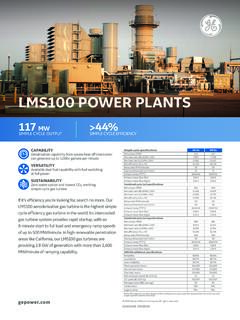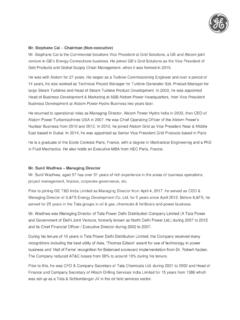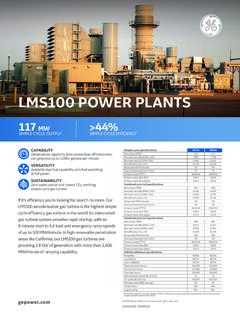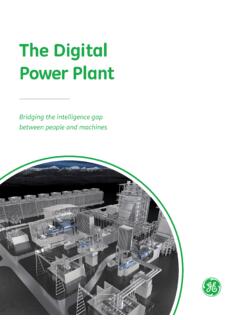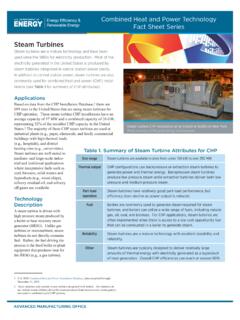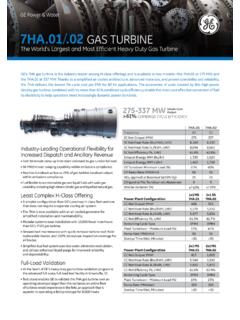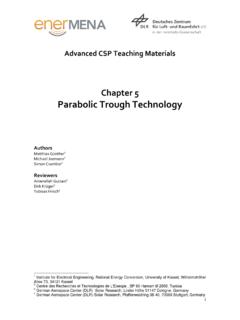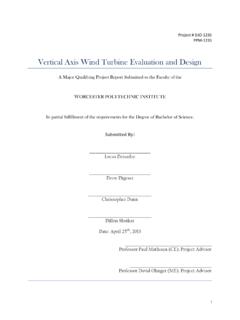Transcription of POWER TO GAS: HYDROGEN FOR POWER GENERATION
1 GE POWER POWER TO GAS: HYDROGEN . FOR POWER GENERATION . Fuel Flexible Gas Turbines as Enablers for a Low or Reduced Carbon Energy Ecosystem GEA33861 February 2019. Dr. Jeffrey Goldmeer General Electric Company, 2019. GE proprietary information and confidential information. POWER TO GAS: HYDROGEN FOR POWER GENERATION GEA33861. ABSTRACT. The desire to reduce carbon emissions from traditional POWER GENERATION assets is driving an increase in POWER production from renewables. However, an issue with large increases in renewable POWER GENERATION is the lack of dispatchability; without adding storage or firming capability, increases in renewables can strain a POWER grid. Gas turbines can be used to fill this gap, but there are questions about the long- term use of these assets in a carbon-free energy ecosystem. An advantage for gas turbines is that they are able to operate on HYDROGEN (H2), which does not provide any carbon emissions when combusted.
2 This includes both new gas turbines and existing units which can be converted to operation on a high H2 fuel. This paper will provide an update on how gas turbines can support a low or reduced carbon electrical grid by operating on a wide variety of lower carbon fuels, including current HYDROGEN capabilities of GE gas turbines, requirements for upgrading existing turbines for operation on HYDROGEN fuels, and potential future technology options. INTRODUCTION. The desire to reduce carbon emissions from POWER GENERATION is creating a fundamental paradigm shift in the POWER GENERATION industry. A direct result of this shift is an acceleration in the installed capacity of renewable POWER sources, including solar and wind. For example, ~86% or 21 GW of the new POWER installations in Europe in 2016 were from renewable sources [1]. With the large and rapid increases in installed capacity of renewable sources, there are concerns about the need to dispatch large blocks of POWER quickly to provide grid stability given the interruptible nature of some renewables.
3 In these situations, the grid regulating agencies used dispatchable POWER GENERATION assets ( gas turbine POWER plants) to balance supply and demand. Although these assets are dispatchable and needed for grid regulation, there are questions being asked about utilization of these plants in a potential future, carbon-free energy ecosystem. There are multiple approaches for low-carbon or carbon-free fuels, including the use of HYDROGEN for POWER GENERATION [2]. Modern gas turbines are capable of operating on a wide range of H2 concentrations, with multiple commercial POWER plants having considerable experience. Thus, gas turbines operating on HYDROGEN could provide the needed grid firming while at the same time generating significantly less carbon dioxide (CO2) emissions. In an energy ecosystem that relies on H2 as a fuel for POWER GENERATION , large volumes of H2 will have to be generated. There are technologies available today that can generate these large volumes of H2, including steam methane reforming and electrolysis of water; see Figure 1.
4 Steam methane reforming is the main production method for most of the HYDROGEN that is generated in the world today. But this process generates CO2, so the use of carbon capture technologies would likely be required for this to be part of a carbon-free ecosystem. Steam Methane Reforming (SMR). Water Reformer Natural Gas Gas Turbine POWER Plants Gas Turbine POWER Plants Green HYDROGEN . Wind CO2. Gas Engine POWER Plants Gas Engine POWER Plants H2. Electrical POWER Electrolysis Natural Gas Pipeline Industrial Customers Electrical Grid Solar Refineries and Residential Customers Petrochemical Applications Figure 1: POWER to HYDROGEN energy ecosystem concept. 2 General Electric Company, 2019. GE proprietary information and confidential information. GEA33861 POWER TO GAS: HYDROGEN FOR POWER GENERATION . Electrolysis of water is not a new concept. But using it to generate the volumes of HYDROGEN required for POWER GENERATION will require a large amount of energy, which could dramatically increase the cost of the HYDROGEN and the resulting POWER .
5 An alternative solution for generating the large volumes might be to generate H2 from an electrolysis using renewable energy. This solution represents a fundamental paradigm shift in the POWER GENERATION industry; the rapid increase in installed capacity of renewable sources is creating excess POWER , leading to curtailment and in some situations creating a negative impact on electricity prices. Using curtailed POWER from renewable sources could potentially supply the POWER needed to generate what is being called green H2 , HYDROGEN generated from electrolysis using renewable energy. This paper will examine the concept of producing and using HYDROGEN in gas turbines as an enabler for a reduced carbon (or carbon free). energy ecosystem. PRODUCTION OF HYDROGEN . HYDROGEN can be generated from a variety of feedstocks and chemical processes, as shown in Figure 2. These include (but are not limited to) photosynthesis using algae, steam methane reforming (SMR) of natural gas, partial oxidation of crude oil, gasification of coal, and electrolysis of water.
6 The next sections will provide details on steam methane reforming and electrolysis as potential pathways to generating HYDROGEN for POWER GENERATION . HYDROGEN . A clean, flexible energy carrier. Natural Gas Solar Wind Geothermal SOURCES OF ENERGY. HYDROGEN can be produced using diverse, domestic resources. Biomass Nuclear Fossil Fuels Electricity PRODUCTION PATHWAYS. HYDROGEN can be produced using a number of different processes. Electrolysis Biological Direct Solar Steam Methane Water Splitting Reforming Figure 2: Pathways to HYDROGEN [3]. Generating HYDROGEN : steam methane reforming Today, most of the HYDROGEN generated in the world comes from steam methane reforming. Much of this HYDROGEN is used in the production of ammonia for fertilizers or in the production of petrochemicals. In this process, natural gas (methane) is reacted with water with a catalyst and heat to generate H2 and CO2 via two reactions [4], [5]: CH4 + H2O CO + 3H2 (1).
7 CO + H2O CO2 + H2 (2). Based on these equations, for each mole of methane used, one mole of CO2 and four moles of H2 are produced. Using the molecular weights listed in Table 1, for each kg of methane consumed, kilogram of H2 and kilograms of CO2 are produced. (For every kilogram of H2 produced, kilograms of CO2 are generated.) Putting this into perspective of the volumes required for POWER GENERATION , a single gas turbine operating 8,000 hours per year would consume approximately 33 million kg of H2 (per year). If the HYDROGEN was generated via SMR, this would produce ~178,000 metric tonnes of CO2 per year. Table 2 shows the rate of CO2 production when scaled to HYDROGEN production for some gas turbine platforms. General Electric Company, 2019. GE proprietary information and confidential information. 3. POWER TO GAS: HYDROGEN FOR POWER GENERATION GEA33861. Table 1: Molecular weight of elements and molecules. Molecular Weight Elements, Molecules Formula (grams/mole).
8 HYDROGEN H2 2. Carbon C 12. Oxygen O2 32. Methane CH4 16. Water H2O 18. Carbon Monoxide CO 28. Carbon Dioxide CO2 44. Table 2: Steam methane reforming requirements supporting 100% HYDROGEN operation. Heat Input 100% H2 CO2 Generated Output . Gas Turbine GJ/hour Flow Rate MW kg/hour Metric tonnes/year (MMBTU/hour) kg/hour 129. GE-10 ~1,140 ~6,250 ~50,000. (122). 350. TM2500 ~3,120 ~16,950 ~135,600. (332). 473. ~4,170 ~22,900 ~183,000. (448). 857. 87 ~7,550 ~41,500 ~332,000. (813). 2,197. 243 ~19,500 ~106,500 ~852,000. (2,083). 2,677. 288 ~23,600 ~130,000 ~1,040,900. (2,537). 4,560. 557 ~40,200 221,000 ~1,800,000. (4,322). ISO conditions operating on natural gas Although generating HYDROGEN via SMR creates carbon dioxide, there are a number of projects that are considering this pathway to generating HYDROGEN by combining it with carbon capture and sequestration (CCS). Examples of projects considering generating HYDROGEN with SMR are the H21 Leeds City Gate and the Magnum Vattenfall project.
9 In the case of the City of Leeds project [6], it is estimated that billion m3 of HYDROGEN would be produced annually to provide heat and electricity to roughly 660,000 people. As part of this system, a 90% carbon capture system is being considered which will capture approximately million tonnes of CO2 annually. The Magnum Vattenfall project in the Netherlands has proposed to upgrade an existing gas turbine to operate on 100% HYDROGEN [7], [8]. The plan as proposed is to generate the HYDROGEN from natural gas, and the resulting CO2 will be captured and stored in underground bunkers. Open questions remain on transporting the HYDROGEN and storing the HYDROGEN at the POWER plant. The challenge of these projects is the goal of creating carbon-free POWER using a technology that requires large scale sequestration of CO2. But, there are technologies that can generate H2 without generating CO2. Generating HYDROGEN : electrolysis of water One established method for generating HYDROGEN is electrolysis of water.
10 Splitting water follows the following chemical reaction: H2O H2 + O2 (3). 4 General Electric Company, 2019. GE proprietary information and confidential information. GEA33861 POWER TO GAS: HYDROGEN FOR POWER GENERATION . Based on this reaction for each mole of water used, 1 mole of HYDROGEN and one-half mole of oxygen are generated. Using the molecular weights listed in Table 1, each gram of water used will generate grams of HYDROGEN and grams of oxygen. (Notice that the total mass is conserved.) In other words, generating 1 gram (1 kg) of HYDROGEN requires 9 grams (9 kg) of water, assuming no losses in the electrolysis process. With this information, it is possible to compute the water required to support the POWER to HYDROGEN concept. Table 3. shows the water required to generate enough HYDROGEN to operate different gas turbines on 100% HYDROGEN . For reference, an Olympic size swimming pool contains 2500 m3 of water; this means that an electrolyzer generating HYDROGEN for a GE-10 would use an equivalent volume of water in approximately 250 hours (just over 10 days).
